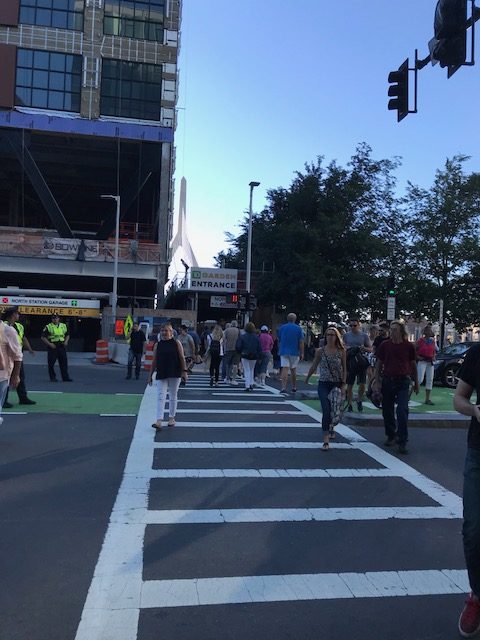So you’re headed to Boston for the U.S. Gymnastics Championships. Welcome!
I am in the TD Garden five days a week. My commuter rail train to work comes through the lower level of the Garden (called North Station,) meaning I’m there at least once a day, usually twice. That makes me uniquely qualified to give you some tips and tricks for navigating the Championships and the area surrounding it. And trust me – you need them.
Warning: The TD Garden is a construction zone. – The Garden is in the midst of a multi-million dollar project to build a retail, restaurant and hotel complex in front of it. Massive skeletons of buildings now block the view of the Garden itself, making it a little confusing to navigate the area if you are not familiar with it.

Therefore, follow the signage for the Garden and don’t necessarily look for a giant building that says “TD Garden.” Two of the three entrances to the building itself have wooden plank covered walkways that can get very crowded before an event or at rush hour.

One of the walkways to the TD Garden and North Station. 
An entrance to the TD Garden and North Station.
Leave some extra time to enter the arena. Some of the entrances to the arena itself (from the concourse) are closed due to the construction. Depending on the size of the crowd, they may open some doors in the stairways to facilitate quicker entrances. If they don’t, you will walk through the North Station concourse towards the ticket office in the middle. Right next to that will be an entrance to the arena itself. (Don’t worry – there are signs.)
Now, for the important stuff: food and coffee.
Coffee
Coffee status: excellent. – Do you like to drink coffee? Well, there might not be any better place in the country to hold this meet. (Except Seattle, of course.)
There are five coffee shops within steps of the arena, including two inside the North Station concourse (which you have to go into to enter the arena.) Okay, so four of them are Dunkin’ Donuts. Boston is obsessed with Dunkin’ Donuts, thus they are on every street corner. There are also Dunkin Donuts in the actual arena as well, bringing this count up to six.

The best Dunkin’ Donuts in the area is on Canal Street, so I recommend hitting up that location for your quality coffee needs. They also offer on-the-go ordering via the Dunkin’ Donuts app, which is key if you intend on getting your coffee in the early morning. Because that Dunkin’ is so good and well run, it often has long lines filled with construction workers ordering for their entire crew, making on-the-go ordering very helpful to those of us who just want to grab an iced coffee and run. That Dunkin’ closes at 6pm or 7pm every night, so that location will be able to carry you up through the evening sessions.

Don’t like Dunkin’? Don’t fret. One of my favorite independent coffee shops in all of Boston is also a stone’s throw from the Garden. Boston Common Coffee is expensive, but if you truly love coffee and good pastries, it is worth every single penny. They also have the BEST yogurt parfaits on the globe. It tastes like the most decadent dessert you’ve ever eaten, but it is actually good for you, with high quality Greek yogurt, house made granola and fruit. I think they run $5 a pop, but if you can splurge, I recommend it. They have a large seating area with wifi, so if your trip to the Championships has to be a working vacation, Boston Common Coffee will be your go-to. It was a favorite for many fans and skaters during the World Figure Skating Championships in 2016, and it will definitely gain a ton of fans during gymnastics as well.
Food & Drink
Bodega Canal (57 Canal Street) makes a heck of a margarita. The Mexican restaurant took the place of a favorite pre-game hangout of my friends, the Grand Canal, and really improved the interior, creating great seating areas for small and large groups. When it’s nice, they open the huge nearly floor-to-ceiling windows which creates such a cool scene on an otherwise dull part of Canal Street. I’ve heard amazing things about their food as well.
If you like beer, you have to at least try Boston Beer Works (112 Canal Street). It’s been a favorite of mine since I moved to Boston 14 years ago. It has multiple locations throughout the Boston area, and I think I may have tried them all except for Lowell at this point. They make all of their own beer, and can get very creative with flavors. During the summer, they sometimes have a Watermelon Beer that is one of my favorite beers of all time. It’s more tangy than sweet, and is really refreshing if the weather is hot. The standard Fenway Pale Ale is a solid choice. If you are a fan of French fries, as I am, their sour cream and chive fries are wonderful, amazing and addicting.
Need a slice of pizza? One of the most famous pizza places in all of Boston is Halftime Pizza, which is right on Causeway Street. It’s a no frills spot that will fill your pizza, pop and beer needs. Its hours vary and it’s not often open post-event, but for a quick bite pre-event or in-between sessions, you can’t go wrong.
Honorable mentions: The Fours, which has been posting some intriguing specials all summer – we’re talking nice dinner salads and some unique sandwich combos; Tasty Burger, which is brand new and adjacent to one of the Garden entrances (this is a perfect place if you have youngsters in tow) and Qdoba, not the best food in the world, but quick and (if you make the right choices) healthy-ish.